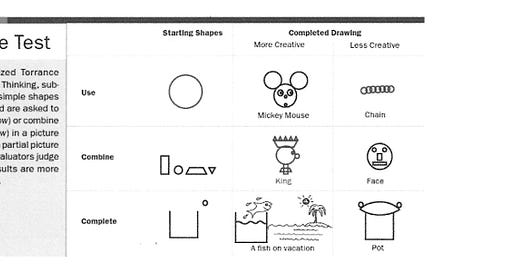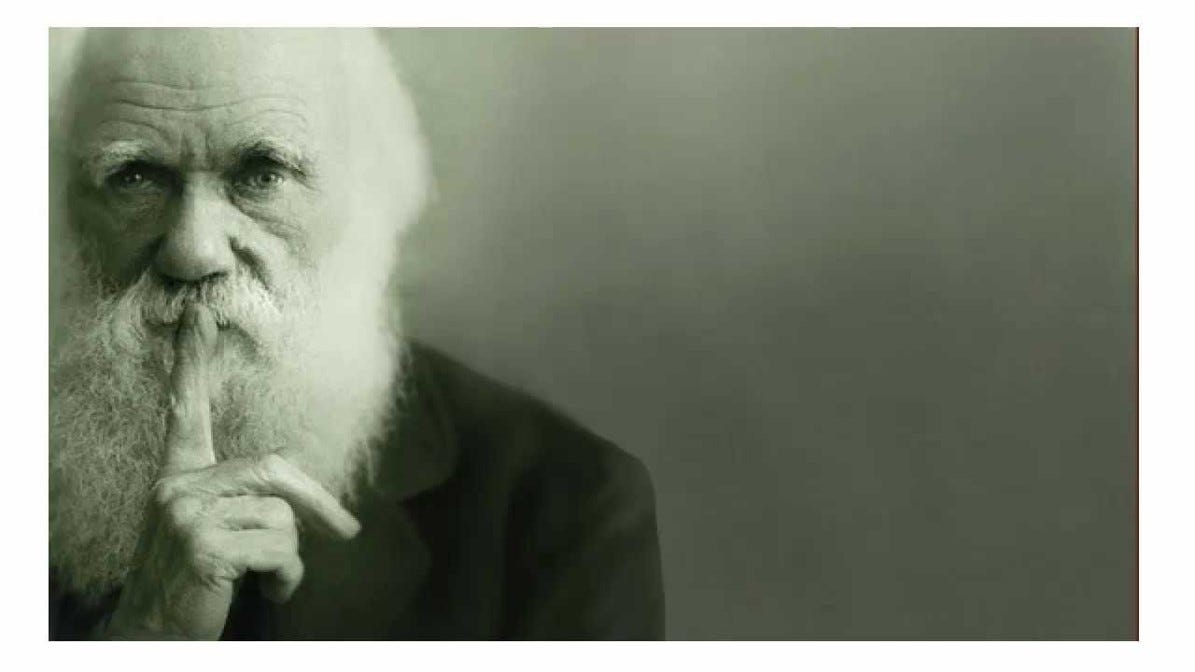“List all of the words that you can think of that start with a B.”
Guilford's Test of Divergent Thinking
“Take five minutes and write down as many uses as you can think of for a brick.”
Alternative Uses Test
“…find a purpose for something that has no definite purpose and elaborate on it so that a clear purpose emerges.”
Torrance Test of Creative Thinking
I started looking for something that has no definite purpose so that I could elaborately ace this creativity test. Otherwise, I could be reciting volume B of the encyclopedia or hitting the bricks in the pavement just to pass a creativity test.
Then it occurred to me: what is the definite purpose of creativity tests?
The obvious answer is that the tests determine who is creative and who is not. Then what? Creativity is not a reserve tank of oil that you can haul out in an emergency. It is not like a measurement of your height. It is not static. It varies by domain, situation, and context.
One good idea is no guarantee that your next ideas will be good. Have you ever gone to a concert hall to hear Chopin’s music played on the concrete piano—invented by Thomas Edison? Is the world clamoring for an earthquake launching machine as invented by Nikola Tesla?
An idea is hatched in the imagination and then presented to the world for acceptance or rejection. Ideas are only deemed creative when the world recognizes the idea’s utility, value, and originality. An original idea is previously unknown.
So, how can you test creativity, something that doesn’t yet exist?
Paul Torrance and Kathy Goff tabulated 255 creativity tests in 1989, including his own Torrance Test for Creative Thinking, perhaps the most famous creativity test. The Torrance test is designed to measure divergent thinking, that is thinking of many possible solutions to a problem. The Torrance test is expensive with a complicated manual. Furthermore, you are deemed “creative” not for your own ideas, but for ideas that meet the test’s expectations. Here is a sample of the Torrance Test:
You complete or rearrange the elements and then you are told if your answer is creative or not or, as you can see, which response is “more creative.” Since the test designers already “know” the answer, the test only measures how well your ideas fit with the test designer’s ideas. In the illustration, the drawing on the right is “less creative.” Or you could look at these drawings in a different way. The chain beside Mickey Mouse could be a bird’s eye view of polymerized DNA. The face next to the king could be an inventor’s idea for a universal electric outlet. The pot next to the sea island could be the landing and recharging station for an inter-galactic portal.
It’s a contradiction in terms: a test implies correct and incorrect answers; creativity seeks the new, original, and unknown. If creativity plunges you into the unknown, how can anyone know the “answers” in advance?
***
The variety of creativity tests reflect different notions of creativity. For example, many tests try to measure divergent thinking, suggesting that creativity is anything outside the norm. (Is there a norm for thinking?) Divergent thinking is defined as
a thought process used to generate creative ideas by exploring many possible solutions.
It is often described as “spontaneous,” “free-flowing,” and “non-linear.” However, divergent thinking is only one aspect of creative thinking. Charles Darwin would have performed poorly on a divergent thinking test—he was meticulous and thorough in his thinking. He studied the Cirripedia barnacle and its host mollusk for 8 years finishing with a 684-page monograph. (Even the mollusk’s mother wouldn’t read that.) Darwin’s gift was his passion to accumulate and then synthesize information over time to generate ideas and insights.
Divergent thinking is only one aspect of creative thinking. Convergent thinking—condensing multiple ideas into one—is also necessary.
The Remote Associates Test (RAT) developed in 1962 tests the ability to find connections between disparate items, joining divergent and convergent thinking.
The RAT test presents 3 words that share a single association. For example, cottage/Swiss/cake can all be linked by the word cheese. The score is based on the number of correct answers, making the test more a vocabulary drill than creating something new, original, and useful.
Another theory of creativity tests is that some people have it and some people don’t. Sort of like: “We can’t define it, but we know it when we see it” axiom. This theory posits that creativity can be found in one’s personality traits—a circular definition: creative people must have creative traits that make them creative. The 1986 Creatrix Inventory presents 56 attitude statements for the individual to rate themselves, such as:
I often see the humorous side when others do not.
Daydreaming is a useful activity.
Another survey-based test is Runco Ideational Behavior Scale asking the individual to agree or disagree with statements using a Likert Scale:
I think things through.
Who is going to say that they don’t think things through? We usually respond to these types of surveys with whatever puts us in the best light, whether it’s true or not. Personality traits such as curiosity, originality, independence, flexibility, or risk taking can contribute to creativity. However, taken alone or collectively these traits do not constitute creativity.
The Alpha Biographical Inventory produces one score for Artistic Creativity, the other for Scientific Creativity, as if your brain has one arts classroom and a separate science classroom. Of course, there are dozens of musically skilled scientists: Einstein, violin; Richard Feynman, bongos; Brian May, astrophysicist and lead guitar for the rock band Queen; Max Planck and Werner Heisenberg played piano, to name a few.
Tabulating activities such as art classes, music lessons, creative writing and others give a reflection of potential creativity. This is an approach that I proposed in Massachusetts with the Creative Challenge Index. But it quantifies activities with no assessment of the quality. You may sit in art class and still only be a lump of clay.
The Consensual Assessment Technique (CAT) replicates the process of presenting ideas to the world outside of a test. The CAT evaluation relies on judges with expertise in the domain. Expert judges are expensive and hard to find, a time-consuming process. One option proposed is the Creative Solution Diagnosis Scale which provides non-expert judges with a scale to assess the creativity of a product.
***
Creativity tests make assumptions about creativity. Is creativity divergent thinking, or a combination of divergent and convergent thinking? Can it be predicted by personality traits, behaviors or activities? Is it problem solving? Or is it the product of one’s life experience?
These tests assume that creative potential can be found in responses to external prompts and tests. Or fill in the multiple-choice questions about your past. They are, in essence, puzzles and brain teasers to be solved regardless of your interest or motivation. The world needs creativity that applies to the task at hand, ideation skills connected to life as we live it.
Creative ideas emerge from the individual’s imagination, which develops from the individual’s experience, interest, observation, and motivation.
So, what is the “definite purpose” of creativity tests?
Perhaps, research begets research. Do creativity tests generate creativity tests to further “creative” research? Maybe.
But aside from research, why do we need to know who is creative and who is not? Knowing someone did well on a creativity test might be a comfort to that person—like the temporary satisfaction of solving a crossword puzzle. But that’s no guarantee that the individual will generate more good ideas for themselves or anyone else.
Furthermore, creativity tests do harm to those who are not deemed creative. These people may feel restricted and shut down their imagination. They fail to contribute because they are “not creative.” We are robbed of diverse perspectives as we wait for some creative elite to solve problems.
Anyone can and everyone should contribute ideas because each of us sees the world differently.
*****
Dan Hunter’s book, Learning and Teaching Creativity, is available from
https://itascabooks.com/products/learning-and-teaching-creativity-you-can-only-imagine
Teachers receive a 20% discount.
Audiobook is available at
https://www.audible.com/pd/Learning-and-Teaching-Creativity-Audiobook/B0CK4BQDJP






*ex nihilo* - out of nothing
-
-
note: two of these (*) show use of italics.
Challenge your dick
by hitting it with a brick
sit on a brick
while rubbing your raw dick. And
then roast a marshmallow on it ---the heated surface of the brick---why not?
Be creative---use your brick to hit
Most EVERY person named "Rick." (They deserve it.)
Then throw the brick back to wherever you found it and continue. To
walk down the cobblestone path--- to
/ / / / / / town
[I am good at this stuff --- but so what]
What one finds consistently, time after time, in dealing with these persons is that they have a bad understanding of what "creativity" may be. They always get that wrong. They never understand creativity. They just cannot handle it. Creativity means a person who lives in the domain of space because you cannot snatch something out of space unless you live in space.